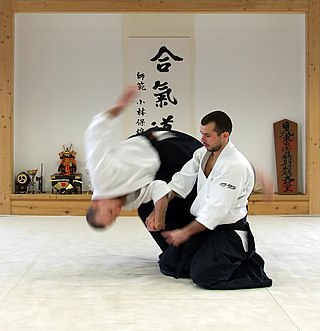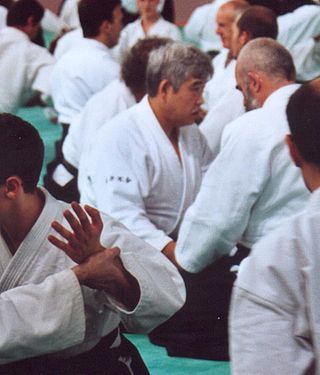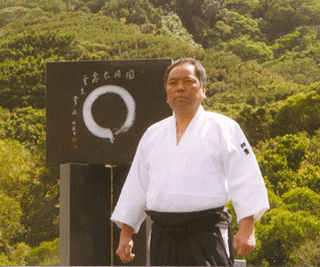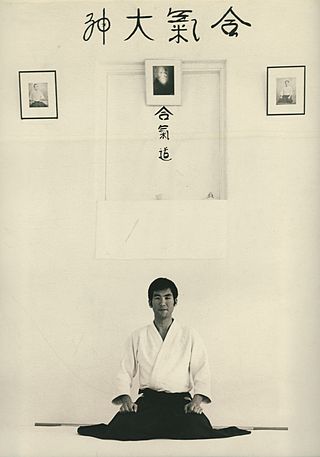
Aikido is a modern Japanese martial art that is split into many different styles, including Iwama Ryu, Iwama Shin Shin Aiki Shuren Kai, Shodokan Aikido, Yoshinkan, Renshinkai, Aikikai and Ki Aikido. Aikido is now practiced in around 140 countries. It was originally developed by Morihei Ueshiba, as a synthesis of his martial studies, philosophy and religious beliefs. Ueshiba's goal was to create an art that practitioners could use to defend themselves while also protecting their attackers from injury. Aikido is often translated as "the way of unifying (with) life energy" or as "the way of harmonious spirit". According to the founder's philosophy, the primary goal in the practice of aikido is to overcome oneself instead of cultivating violence or aggressiveness. Morihei Ueshiba used the phrase masakatsu agatsu katsuhayabi" to refer to this principle.
The Ki Society is an aikido organization founded by Koichi Tohei in 1971, while he was the chief instructor at the Aikikai Hombu Dojo. The official Japanese name of the organization is Shin Shin Toitsu Aikido Kai (心身統一合気道会), but it is also known in English-speaking countries as "Ki Society". Its foundation reflected Tohei's differences with the Aikikai, and his own emphasis on developing the concept of Ki. Students of the art are graded in Ki and Aikido classes. Tohei's Ki lessons come from Shin Shin Tōitsu-dō (心身統一道), meaning "the way of realizing the [original] unity of mind and body". The martial discipline of the art is frequently referred to as Ki-Aikido, particularly in the Western world.
Morihiro Saito was a teacher of the Japanese martial art of aikido, with many students around the world. Saito's practice of aikido spanned 56 years, from the age of 18, when he first met aikido founder Morihei Ueshiba, until his death in 2002.

Koichi Tohei was a 10th Dan aikidoka and founder of the Ki Society and its style of aikido, officially Shin Shin Toitsu Aikido, but commonly known as Ki-Aikido.
Kokikai (光気会) is a style of Aikido, founded by Shuji Maruyama. The organization is called Kokikai Aikido International.
Benjamin G. Galarpe is considered to be the father of Aikido in the Philippines. He began training in 1957 in Guam under Harry S. Ito. Four years later he earned his Shodan (rank) degree from the Japan Aikido Hombu Dojo. He was the first Aikido representative of the Japan Aikikai Hombu Dojo to spread and propagate Aikido in the Philippines. Morihei Ueshiba, the founder of Aikido, promoted him to the degree of Nidan after advanced training in the World Aikido Hombu in Sanjukuku, Tokyo, Japan. While teaching in the Philippines, he held exhibitions in Bicol, Pampanga, Baguio, Olongapo City, Clark Air Base in Angeles City, Cebu City, Batangas City, and other places within the Philippines. Benjamin Galarpe's students, namely Chan Hok-seng, Ernesto Talag, Max Tian and Manuel "Omar" Camar, became the prime movers of the Aikido Movement in the Philippines.

Toshirō Suga is a Japanese aikido instructor. He holds the rank of 7th dan Aikikai.
Shin Shin Toitsu Aikido (心身統一合氣道) or Ki Aikido is a Japanese martial art, a gendai budo . It is part of the martial arts derived from aikido, which appeared after its founder's death in 1969. It started in early 70's with the creation of the Ki Society of Koichi Tohei, the previous Aikikai's Chief Instructor. This martial art focuses on mind and body coordination and is based on aikido techniques and Japanese yoga and promote non-violent conflict solving and self-development.
Tadashi Abe was the first aikido master to live and teach in the west. He began training in Aikido in Osaka in 1942 and went on to train directly under the founder of the art Morihei Ueshiba at Iwama as an uchideshi during World War II. In 1952, after graduating in law from Waseda University, he moved to France where he studied law at the Sorbonne and taught aikido as a 6th Dan representative of Aikikai Honbu. After seven years he returned to Japan. By 1964 he was a 7th dan black belt in aikido.

Fumio Toyoda was a Japanese aikido teacher and lay Zen master who taught extensively in the United States and Europe. He is one of few teachers to explicitly teach aikido from the perspective of Zen Buddhism.
Though the art of aikido is characteristically different from other Japanese martial arts, it has a variety of identifiable styles within the family of organizations descending from the teachings of Morihei Ueshiba.

Ken Ota and Miye Ota are a married couple known for teaching martial arts, ballroom dancing, and social graces at their "cultural school" located in Goleta, California.
Frank Doran is an aikido teacher in the United States and has been chief instructor of Aikido West in Redwood City, California since 1978. He was awarded the rank of 8th dan shihan from the Aikikai in January 2017.
Shizuo Imaizumi (今泉鎮雄), born 1938) is a Japanese aikido teacher. He holds a rank of 7th dan from the Ki Society, but broke away from the Ki Society in 1987 to found the Shin-Budo Kai style of aikido.
Alan Ruddock was an Irish Martial Arts pioneer, teacher and writer. He introduced both Aikido & Karate to Ireland and was the founder of the Aiki no Michi and its interpretation of Aikido. Ruddock was one of the few western Aikido practitioners and only Irish national who studied directly under the founder of Aikido, Morihei Ueshiba ("O-Sensei").

Harry Kiyoshi Ishisaka was a leading sensei, or master of the Japanese martial art of aikido. Founder and chief instructor of the Orange County Aiki Kai for much of his life, he did much to popularize aikido in southern California. His obituary in Black Belt magazine described him as "one of the foremost practitioners of aikido in America."

Jon MamoruTakagi was a pioneer of aikido in the United States. He founded Arizona Aikikai, the first aikido dojo in Arizona. A second-generation American of Japanese descent born in Hawaii, Takagi's career was unexpectedly cut short when he was killed by a drunk driver.

Stanley A. Pranin was an American martial artist, founding publisher, and editor-in-chief of Aikido Journal. Pranin, a researcher and archivist of aikido, has written and published several books and many articles about aikido, Daito-ryu Aikijujutsu, and Morihei Ueshiba and was an influential figure in the aikido world.
Seidokan Aikido is a style of Aikido and organization founded in Los Angeles, California in 1981 by Roderick Kobayashi, formerly a top instructor in the Ki Society. Kobayashi brought to the new organization the strong influence of his teacher Koichi Tohei, and Shin Shin Toitsu Aikido. Although independent and never formally affiliated with any parent organization, Seidokan's style and teachings were recognized by 2nd Dōshu Kisshomaru Ueshiba as a legitimate interpretation of the teachings of his father, Aikido founder Morihei Ueshiba.
Roderick T. Kobayashi was an American aikido teacher and founder of Seidokan Aikido. He is one of the teachers profiled in the book Aikido in America.







